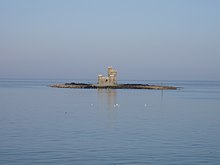St Mary's Isle
 |
|
| Coordinates | 54°09′01″N 4°28′07″W / 54.15028°N 4.46861°WCoordinates: 54°09′01″N 4°28′07″W / 54.15028°N 4.46861°W |
|---|---|
| Location | Douglas, Isle of Man |
 |
|
| Coordinates | 54°09′01″N 4°28′07″W / 54.1504°N 4.4687°W |
|---|---|
| Location | Douglas, Isle of Man |
| Designer | John Welch |
| Type | Historic landmark |
| Material | Granite |
| Width | 52 m (171 ft) |
| Height | 12.5 m (41 ft) |
| Beginning date | circa 1831 |
| Completion date | 1832 |
| Dedicated to | Royal National Lifeboat Institution |
St Mary's Isle (also known as Conister Rock or, colloquially, the Tower of Refuge, Manx: Kione y Sker or Creg Voirrey) is a partially submerged reef within Douglas Bay on the Isle of Man.
The reef is situated not far from the current ferry terminal. Its eastern part, the Conister Shoals, had to be blasted away when a new harbour breakwater was built in the early 1980s. The rocks are only fully submerged during the spring high tides; in the same period, they can be accessed very briefly on foot at the corresponding low tides.
Conister is a corruption of the Manx Kione y skeyr meaning the 'head of the reef'.
On Friday November 19, 1830, under the command of Lieutenant John Tudor R.N., the packet steamer St George arrived in Douglas from Liverpool with mail and passengers.
The St George belonged to the Saint George Steam Packet Company of Liverpool and at that time was engaged in competition with the newly established Isle of Man Steam Packet Company.
Once her passengers and mail were unloaded, the St George proceeded to take her anchorage in the vicinity of Conister Rock using the fixed chain cable which had been secured for the task. The night was stormy, with strong gusts of wind from the southwest which increased in ferocity as the wind backed to the southeast on the morning of November 20. At 05:00hrs the chain cable holding the St George began to give way and she began to drive in between the Pollock and Conister rocks.
Steam had been kept up during the night, with the crew at their stations, but the force of the sea together with the ship's proximity to the Conister Rock meant she struck the rock before any attempt to back her out could prove successful. The St George struck the rock violently, immediately filled and settled down forward, with her head to the land and lying almost broadside to the most ruggered part of the rock.
Lieutenant Tudor immediately ordered distress signals to be made as well as the foremast to be cut away with a view to forming a raft so as that when the dawn came they might be rescued by boats from the lee side of the vessel, but this was found to be impractical. From his home at the Fort Anne Sir William Hillary observed the disaster taking place and immediately made for the pier in order to initiate a rescue. Together with Lt Robinson (RN), William Corlett (agent for the St George Steamship Company), Issac Vondy his coxswain, and a volunteer crew of 14 Sir William set out to render assistance.
...
Wikipedia
